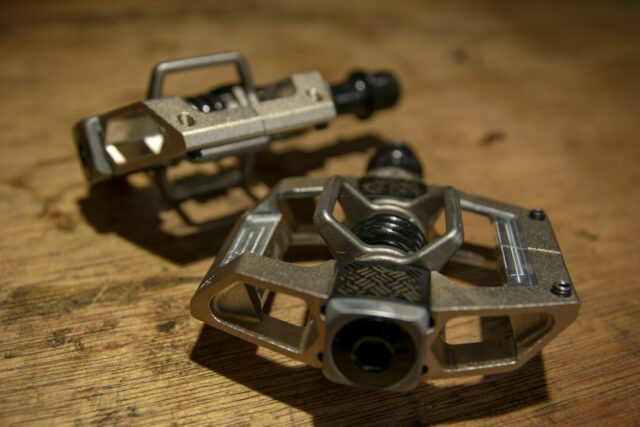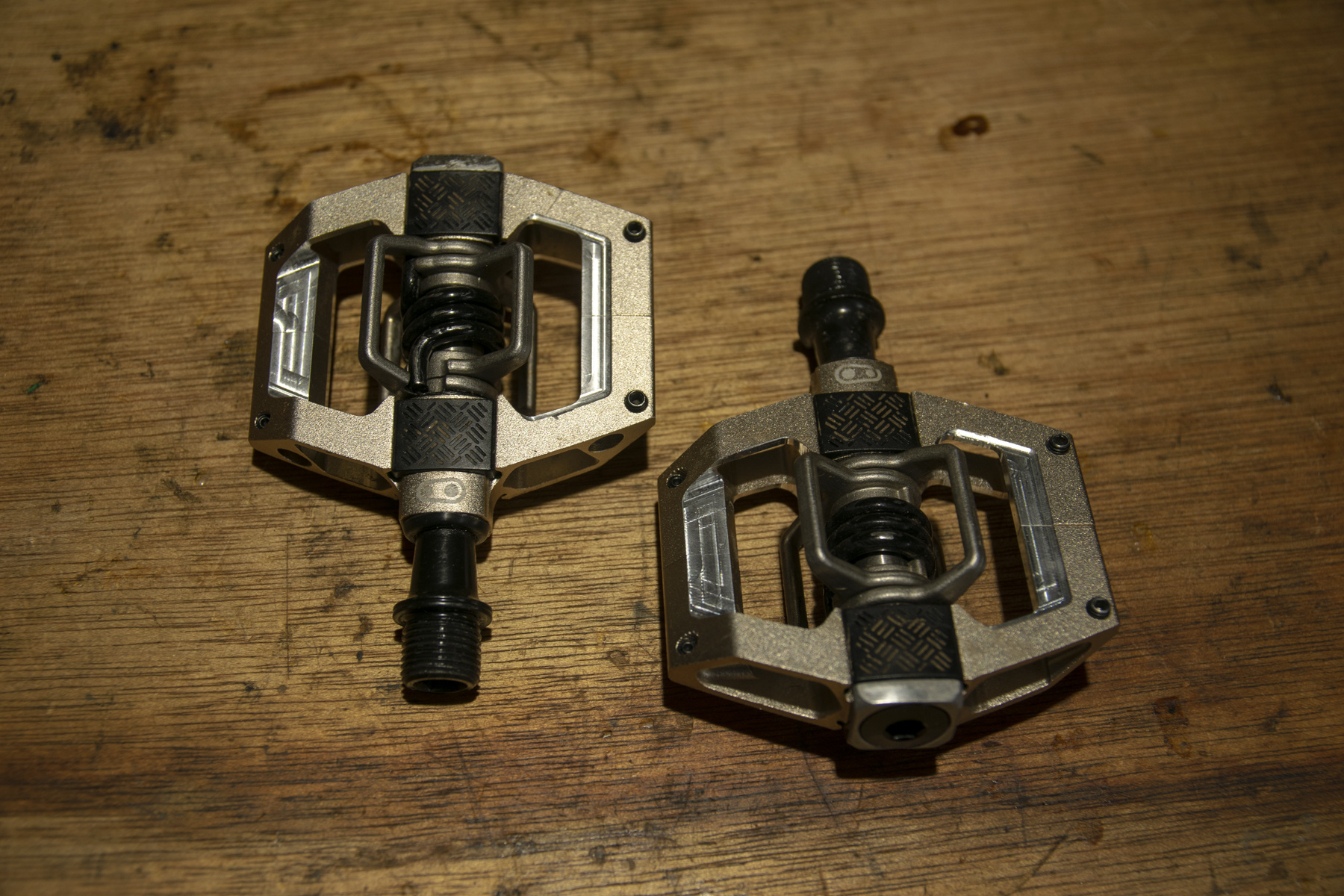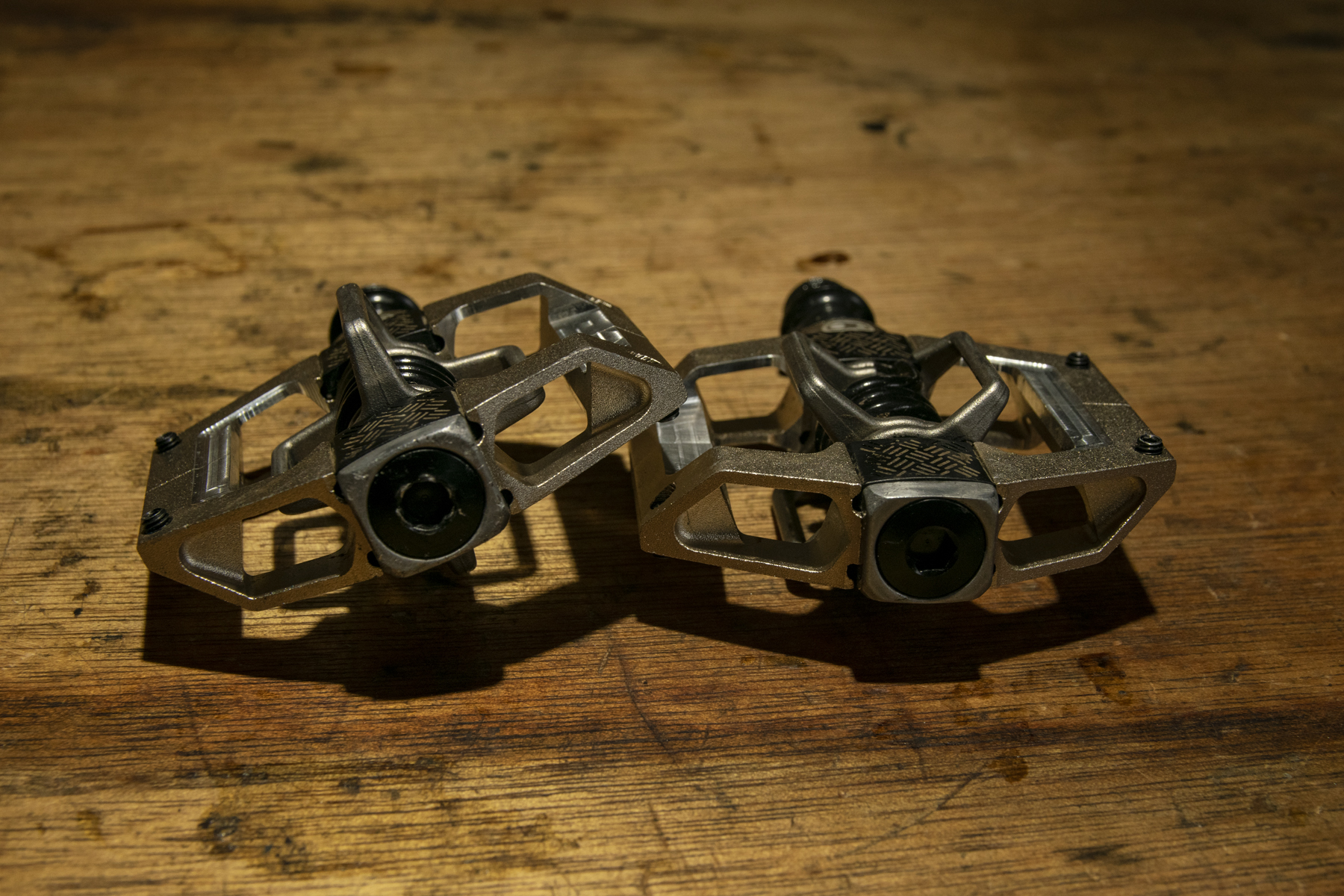Crank Brothers Mallet Trail Pedals
Blister’s Measured Weight: 180 and 180 g (pedals only, w/o cleats)
MSRP: $180
Bolted to: Santa Cruz Tallboy, Trek Fuel EX, Guerrilla Gravity Trail Pistol
Reviewer: 6’, 170 lbs / 183 cm, 77.1 kg
Test Locations: Washington
Test Duration: 4 months

Intro
Crank Brothers has been making clipless pedals for a long time now, and their fans, of which there are many, have long touted them for their extremely easy entry and exit and very good mud-clearing performance, in particular.
But I have to admit that, before I started testing the Mallet Trail, it had been a very long time since I’d ridden a Crank Brothers pedal, and my prior experiences hadn’t been great. But I was overdue to give them another shot, and having now spent a substantial amount of time on the Mallet Trail, I do think they’re a good option for the right folks.
Design
The heart of the Mallet Trail’s design is, unsurprisingly, Crank Brothers’ signature four-sided clipless mechanism that they’ve been using since the original Eggbeater pedal that they launched way back in 2001. It’s comprised of two crossed pairs of wings with a spring keeping them crossed at a 90-degree angle, which the cleat wedges open to clip in or out. Release tension is non-adjustable.
That basic mechanism looks a whole lot like an eggbeater (hence the name of the original version), but the Mallet Trail adds an additional platform around the central clip mechanism for additional support. That platform features a pair of set screw traction pins at the leading edge and a set of swappable plastic “traction pads” (the black pieces in the photo below) on either side of the clip mechanism, to fine-tune the pedal-to-shoe interface. They’re the same design as used on the bigger Mallet E and Mallet DH, for folks who are familiar with those. A set of 1 mm thick ones come installed on the pedals, with thicker 2 mm ones in the box; the pads are keyed and slide in from the outer edges of the pedals (with the outer spindle cap removed), and swapping them only takes a few minutes, though you’ll likely need a tire lever or similar implement to apply some leverage. The Mallet Trail pedals are currently available in black, purple, or “Champagne” and come with a five-year warranty.

Crank Brothers also offers four different versions of their cleats to further fine-tune the pedal feel and release properties: the “Standard” version and an “Easy Release” option, both of which are available with 0° or 6° of lateral float. The Mallet Trails ship with the 6° Standard cleats, but the other options are available separately, and all are compatible with Crank Brothers’ other pedal models as well.
In short, the standard cleats have a 15° release angle (how far you need to rotate your shoe before they unclip) as compared to 10° on the easy versions. The cleats are also asymmetric (i.e., right- and left-side specific) and if you want a wider release angle yet, swapping the standard cleats from side to side gets you to 20°.
As with a lot of clipless systems, Crank Brothers also includes a variety of cleat shims to set the spacing between the sole of the shoe and the cleat to further fine-tune the interaction between the sole of the shoe and the pedal body. Of particular note, though, is the fact that Crank Brothers recommends running the Mallet Trail pedals with no shim when paired with their own Mallet shoes, in contrast to the Mallet E and Mallet DH pedals, which are meant to use the 1.5mm-thick gray shim that the shoes ship with. Having used the Mallet Boa pedals with the Mallet Trails, I did indeed prefer running no cleat shim and the thinner 1 mm pedal traction pads to mitigate the side-to-side rocking that I felt with the cleat shim installed. That setup felt quite good (more on it below) but the combination might be annoying for folks who want to use both Mallet Trails and one of the other Mallet pedal versions with the same shoe setup.

On the Trail
I ran Crank Brothers pedals for a while in the 2000s, but gave up probably a decade ago after breaking a number of pairs of Acids and first-generation Mallets in myriad and surprising ways. So when Crank Brothers reached out to say that they had a new Mallet Trail pedal coming, I wasn’t initially very excited about the prospect. But after a little consideration, I told myself that I hadn’t ridden a Crank Brothers pedal in at least 10 years, and (in theory) that’s more than enough time for them to right the ship vis-a-vis durability. I owed them another shot.
With that in mind, I’m pleased to say that the Mallet Trails have held up great so far and that they offer a combination of feel and performance that’s genuinely different from their most prominent competitors — for better or worse, depending on your personal preferences.

Particularly for this sort of pedal with a smaller platform around the clipless mechanism, once you dial in the support pad and cleat shim configuration, the Mallet Trail does a particularly good job of supporting the shoe and doing away with the side-to-side rocking sensation you can get from sloppier, less supportive interfaces. There’s definitely less support fore-aft than there is laterally (unsurprisingly, given the length of the platform) and I imagine that most folks will want to run at least moderately stiff shoes with the Mallet Trail to match.
Clipping into the Mallet Trail pedals is generally easy, though there can be a little bit of inconsistency depending on how the central clip mechanism is clocked within the main pedal body. Since the eggbeater mechanism can rotate relative to the pedal body, the wings aren’t always in the same position when you go to clip in, and if one is pointed straight up, it can take a little hunting around with your foot to get everything lined up.
I found that the ideal technique was to make the forward movement of my foot a little more exaggerated than I tend to with other clipless pedal systems, where I try to bring the shoe in slightly toe-down and hook the front of the cleat on the forward part of the clipless mechanism, then step down. With the Mallet Trails, starting that motion a little farther back and moving my foot forward onto the pedal more seems to help roll the eggbeater mechanism into position and make the whole process go more smoothly. It’s a subtle readjustment, and with that made, the Mallet Trails are easy to step into and take a relatively light amount of force to click in.

Another standout trait of the Mallet Trails is that, even with the standard release cleats that I’ve been using, is that they’re exceptionally easy to clip out of. The force required is notably light, and there’s only modest resistance (and feedback) as you near the release point before they pop free. The 15° release angle of the standard cleats doesn’t feel too terribly different from Shimano SPD or HT pedals in terms of how far you need to move to clip out, but the amount of force needed is significantly lower (subject to the amount of release tension dialed in on the latter two systems, both of which are adjustable) and especially with the HTs, there’s a more appreciable ramp up in resistance as you near the release point.
Whether that’s a pro or a con of the Mallet Trails is going to come down to personal preference, with folks who prefer easy and instantaneous release more likely to get along with the Mallet Trails. Personally, one of the reasons I’ve primarily moved to HT pedals in recent years is that I like to be able to dial in firmer release values and get a little more feedback when I’m about to clip out than the Mallet Trails offer. I’ve been riding clipless pedals on mountain bikes for… longer than I care to admit, and the unclipping motion is so thoroughly hardwired at this point that I really don’t need to make it especially easy, but it’s very easy to imagine how other folks would feel differently.
Particularly in my first few rides on the Mallet Trails, I found myself occasionally unclipping from my outside foot in the middle of a corner, as I pivoted my hips to initiate bringing the back end of the bike around — a decidedly disconcerting experience. (I don’t generally have that same issue with new Shimano pedals, but have experienced it a bunch on more worn ones, which was a big part of what got me to try HT pedals in the first place, so this is definitely partially a me problem.)
Swapping the cleats side-to-side for the 20° release position helped, as did simply spending more time on the Mallet Trails and getting used to them, and I’ve been staying in them in corners just fine now, but I’d still personally prefer firmer release tension and more feedback that I’m nearing the release point. HT pedals do that really well, with a decidedly spring-y feel to their float that helps guide the shoe back to center, and a smooth ramp-up in force needed to keep twisting your foot outward as you near the release point — much more on that in a review of their new T2 and X3 pedals, coming very soon.
The other instance in which I’ve inadvertently clipped out of the Mallet Trails a few times is hitting the bottom of the pedal on an obstacle — which makes sense, given the scissor action of the release mechanism. An impact from below spreads the wings open, releasing the cleat. It’s only happened a small handful of times, generally when pedaling and bringing the pedal down directly on top of something (rather than a more forward impact when coasting) but it can happen.

On the plus side, the very open clipless mechanism clears mud and snow extremely well, and while their bearing durability was a definite shortcoming of Crankbrothers pedals of yesteryear, the Mallet Trails have held up nicely through much of the PNW winter so far, and the grease in the spindle is still impressively clean and free of gunk. Crank Brothers also does a good job of making spindle rebuild kits available (another factor that pushed me to HT from Shimano pedals) so you can take care of any issues that may arise without having to just replace the pedals.
So if you want a relatively light clipless pedal that’s got notably good shoe support for its size, and offers especially easy entry and exit (with a few quirks), the Mallet Trails are really promising. And at least so far, their durability seems to be quite solid, with a five-year warranty and good spare parts availability to act as a safeguard. Folks who want firmer release tension and more feedback about the pedal release point will be better off elsewhere, but if ease of exit is a top priority, Crank Brothers’ mechanism remains the best I’ve tried to date, and the construction of the Mallet Trails seems a whole lot better than Crank Brothers pedals of the past.
Bottom Line
The new Mallet Trail pedals are a lighter-weight Trail-oriented version of Crank Brothers’ Mallet pedal line and are going to be most appealing for people who want pedals that are very easy to clip out of, clear mud well, and offer better-than-average support for a pedal with a fairly modest platform (though the Mallet Trails are definitely short of their bigger, heavier counterparts on that front). The Crank Brothers pedal mechanism can still be opened with a pedal strike from below, which can be an annoyance, and folks who prefer stronger retention / firmer release settings are likely to be left wanting, but if you like the feel of Crank Brothers’ other pedals and want a lighter, more compact version of the existing Mallet E or Mallet DH, the Mallet Trail just might be the ticket.
